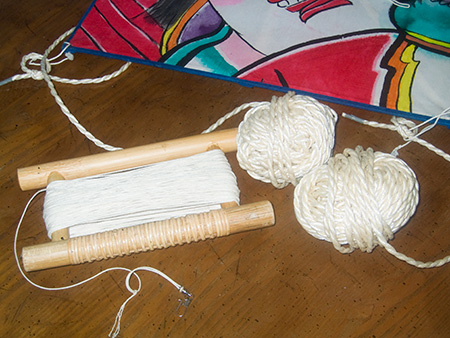It was windy so I thought I’d fly my kite, but the wind died down before I could get it in the air. I received this kite as a gift from the Hakodate Sports Kite Club in 1996, but I’ve never flown it since I brought it back to the US. It is a simple square kite, handmade from bamboo and hand painted in a traditional ukiyo-e design. The kite has a string across the top back to bend the leading edge into a curve for more lift. The string is covered with a flap of plastic tape, so when the wind is strong enough to lift the kite, it produces a menacing buzz.

The reason I never flew this kite is because I could not find the kite spool and rope tails, but now I found them and can assemble the kite. The rope is a light plastic fiber, the spool is made from wood dowels with a wonderful bamboo wrap, I guess that’s for a better grip.

The wind picked up the next day for a bit, so I went out to fly the kite, without much success. The wind was inconstant, the kite needs a strong wind to get high enough to put the tails in the air. Until it gets high enough, it just swoops around and crashes. I tried adjusting the bridle, and managed to get it aloft and upright for about 5 seconds, then the wind gave out. But for a brief moment, it was going straight up, producing an aggressive buzzing sound, rising into the sky on its tails.
Update Sept. 14: I took the kite out every day for the last 3 days. Meteorologists predicted increasing winds, but they were never constant enough to keep the kite up. I figure it takes a constant 10mph wind to fly the kite, I got a few gusts higher than that, and the kite went up. Then it went down. It is easy to tell when you have enough wind, the kite buzzes.
But the kite is very unstable. I discovered it had 3 cross-ties that had to be pulled taut and tied, not just the one at the top. Now the whole kite has a more curved and aerodynamic shape. But still it’s very hard to fly, until it gets high enough for the tails to weigh it down. Once it got about 20 feet off the ground, the kite flew straight up.